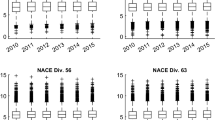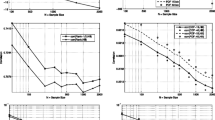Abstract
This paper explores firm growth rate distribution in a Gibrat’s Law context. It is novel in two respects. First, rather than limiting the analysis to a focus on the conditional mean, we investigate the entire shape of the distribution. Second, we show that differences in the firm growth rate process between large and small firms are highly circumstantial and depend on the industry dynamics. The data used include more than 9,000 Danish manufacturing, services and construction firms. We provide robust evidence indicating that firm growth studies should concentrate less on explaining means and instead focus on other parts of the firm growth rate distribution.



Similar content being viewed by others
Notes
However, this empirical finding has been attributed to sample attrition/selection bias. Exits are not included in these studies, and the sample includes predominantly small firms, producing a bias in the size variable in favor of small firms. Harhoff et al. (1998), however, indicated that the negative correlation persists even when controlling for sample attrition. For reviews of Gibrat’s Law, see e.g. Sutton (1997) and Lotti et al. (2003).
References
Arthur BW (1994) Increasing returns and path dependency in the economy. The Universty of Michigan Press, Ann Arbor
Balassa B (1965) Trade liberalization and ’revealed’ comparative advantage. Manch Sch Econ Soc Stud 32:99–123
Barney JB (1991) Firm resources and sustained competitive advantage. J Manage 17(1):99–120
Barney JB (2001) Is the resource-based view a useful perspective for strategic management research: yes. Acad Manage Rev 26(1):41–56
Bottazzi G, Secchi A (2003) Why are distributions of firm growth rates tent-shaped? Econ Lett 80:415–420
Bottazzi G, Cefis E, Dosi G (2002) Corporate growth and industrial structure. Some evidence from the Italian manufacturing industry. Ind Corp Change 11(4):705–723
Bottazzi G, Dosi G, Lippi M, Pammolli F, Riccaboni M (2001) Innovation and corporate growth in the evolution of the drug industry. Int J Ind Organ 19(7):1161–1187
Buchinsky M (1998) Recent advances in quantile regression models: a practical guideline for empirical research. J Hum Resour 33(1):88–126
Cantner U, Krüger JJ (2007) Empirical tools for the analysis of technological heterogeneity and change. In: Hanusch H, Pyka A (eds) Companion to neo-Schumpeterian economics. Edward Elgar, Cheltenham
Coad A (2006) A closer look at serial growth rate correlation. LEM working paper series. Sant’ Anna School of Advanced Studies, Pisa
Coad A, Rao R (2006) Innovation and firm growth in high-tech sectors: a quantile regression approach. LEM working paper series. Sant’ Anna School of Advanced Studies, Pisa
Davies SW, Geroski PA (1997) Changes in concentration, turbulence, and the dynamics of market shares. Rev Econ Stat79(3):383–391
Dosi G, Nelson RR, Winter SG (2000) The nature and dynamics of organizational capabilities. Oxford University Press, Oxford
Dunne P, Hughes A (1994) Age, size, growth and survival: UK companies in the 1980s. J Ind Econ 42(2):115–141
Dunne P, Roberts MJ, Samuelson L (1989) The growth and failure of us manufacturing firms. Q J Econ 104(4):671–698
Eisenhardt KM, Martin JA (2000) Dynamic capabilities: what are they? Strateg Manage J 21(10–11):1105–1121
Evans DS (1987a) The relationship between firm growth, size and age: estimates for 100 manufacturing industries. J Ind Econ 35(4):567–581
Evans DS (1987b) Tests of alternative theories of firm growth. J Polit Econ 95(4):657–674
Foss NJ (1997) The classical theory of production and the capabilities view of the firm. J Econ Stud 24(5):307–323
Gibrat R (1931) Les inégalitiés economiques. Requeil Sirey, Paris
Hall BH (1987) The relationship between firm size and firm growth in the US manufacturing sector. J Ind Econ 35(4):583–606
Harhoff D, Stahl K, Woywode M (1998) Legal form, growth and exit of west german firms—empirical results for manufacturing, construction, trade and service industries. J Ind Econ 46(4):453–488
Hart PE, Oulton N (1996) Growth and size of firms. Econ J 106:1242–1252
Hart PE, Prais SJ (1956) The analysis of business concentration: a statistical approach. J R Stat Soc 119:150–191
Hymer S, Pashigian P (1962) Firm size and rate of growth. J Polit Econ 70(6):556–569
Ijiri Y, Simon HA (1977) Skew distributions and sizes of business firms. North-Holland, New York
Jovanovic B (1982) Selection and the evolution of industry. Econometrica 50(3):649–670
Koenker R (2005) Quantile regression. Econometric Society monographs no. 38. Cambridge University Press, New York
Koenker RW, Basset GJ (1978) Regression quantiles. Econometrica 46(1):33–50
Koenker RW, Hallock KF (2001) Quantile regression. J Econ Perspect 15(4):143–156
Krugman P (1991) Increasing returns and economic geography. J Polit Econ 99(3):483–499
Long JS, Ervin LH (2000) Using heteroscedasticity consistent standard errors in the linear regression model. Am Stat 54(3):213–224
Lotti F, Santarelli E, Vivarelli M (2003) Does Gibrat’s law hold among young, small firms? J Evol Econ 13:213–235
MacKinnon JG, White H (1985) Some heteroskedasticity consistent covariance matrix estimators with improved finite sample properties. J Econom 29(3):52–57
Mansfield E (1962) Entry, Gibrat’s law, innovation, and the growth of firms. Am Econ Rev 52(5):1023–1051
McKelvey B, Andriani P (2005) Why gaussian statistics are mostly wrong for strategic organization. Strateg Organ 3(2):219–228
Penrose ET (1959) The theory of the growth of the firm. Basil Blackwell, Oxford
Reichstein T, Dahl MS (2004) Are firm growth rates random—analyzing patterns and dependencies. Int Rev Appl Econ 18(2):225–246
Reichstein T, Jensen MB (2005) Firm size and firm growth rate distributions—the case of Denmark. Ind Corp Change 14(6):1145–1166
Schumpeter JA (1942) Capitalism, socialism and democracy. Unwin, London
Simon HA, Bonini CP (1958) The size distribution of business firms. Am Econ Rev 48(4):607–617
Stanley MHR, Amaral LAN, Buldyrev SV, Havlin S, Leschhorn H, Maass P, Salinger MA, Stanley EH (1996) Scaling behaviour in the growth of companies. Nature 379:804–806
Sutton J (1997) Gibrat’s legacy. J Econ Lit 35(1):40–59
Author information
Authors and Affiliations
Corresponding author
Rights and permissions
About this article
Cite this article
Reichstein, T., Dahl, M.S., Ebersberger, B. et al. The devil dwells in the tails. J Evol Econ 20, 219–231 (2010). https://doi.org/10.1007/s00191-009-0152-x
Published:
Issue Date:
DOI: https://doi.org/10.1007/s00191-009-0152-x




